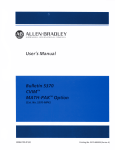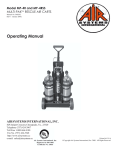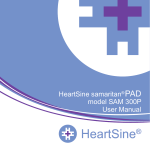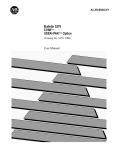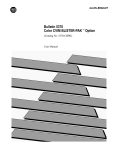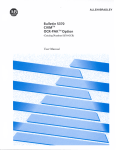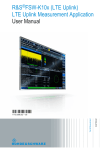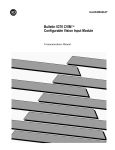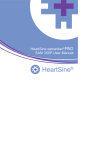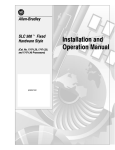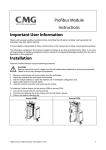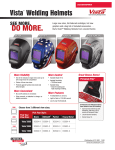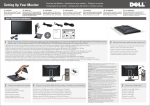Download 5370-ND005-RN1, CVIM MATH-PAK Firmware Release Notes
Transcript
Release Notes A–B RN CVIM MATH–PAK Firmware Release Notes This document lists and describes changes and enhancements to the MATH-PAK firmware. The information in this document should be considered as additional to the CVIM MATH-PAK User Manual, Catalog No. 5370–ND005 (Series A). Enhancements in Bulletin 5370–MPK MATH–PAK Firmware Revision A04 This section contains changes and enhancements that are effective with the A04 release of the CVIM MATH–PAK firmware. Firmware Compatibility MATH–PAK firmware revision A04 requires CVIM firmware revision C05 (or higher). Also, if used with other CVIM packages, USER–PAK firmware must be revision A03 (or higher), and OCR–PAK firmware must be revision B03 (or higher). Corrupt Formula Detection MATH–PAK formulas can be corrupted by CVIM USER–PAK and CVIM OCR–PAK options. The corruption has been eliminated in USER–PAK firmware revision A03 and in OCR–PAK firmware revision B03. However, if an old configuration containing a corrupt formula is archived internally, all formulas (and any templates, OCR match strings, and USER–PAK configuration data) will be erased and set to their default settings. The Configuration Fault bit will be set to allow a host computer to detect this condition. At this time, you will have to re–enter the lost configuration data. Formula Results From Other Toolsets The MATH–PAK User’s Manual indicates that when a simultaneous trigger is used for Toolset 1 and Toolset 2, formulas in Toolset 2 can access formula results in Toolset 1. CVIM firmware revision C05 is required to ensure that the formula results from Toolset 1 are valid. Attempts to read formula results from Toolset 1 with CVIM firmware revision C04A or earlier revisions could produce inconsistent results. 1 Release Notes MATH–PAK Null Formula Name Display If a formula name is entered as a “null string” (just a carriage return), the number of the formula will be displayed on the Results Page display panel. Access to Additional Inspection Data MATH–PAK formulas can now be used to access additional inspection data. The following information is provided as a supplement to the table on page 20 of the MATH–PAK User’s Manual. Key Code *Operand Name *Subcode Type of Results Data Returned to Formula GAGEn.s (n = 1 to 32) (s = 0 to 25) n.20 n.21 n.22 n.23 n.24 n.25 Gage total fault count. Gage lower fail limit. Gage lower warning limit. Gage upper warning limit. Gage upper fail limit. Gage nominal value. W WINn.s (n = 1 to 24) (s = 0 to 25) n.20 n.21 n.22 n.23 n.24 n.25 Window total fault count. Window lower fail limit. Window lower warning limit. Window upper warning limit. Window upper fail limit. Window nominal value. RL RLn.s (n = 1 to 3) (s = 0 to 27) n.20 n.25 n.26 n.27 Reference line total fault count Reference line nominal (X). Reference line nominal (Y). Reference line nominal (theta). RW RWn.s (n = 1 to 3) (s = 0 to 27) n.20 n.25 n.26 n.27 Reference window total fault count Reference window nominal (X). Reference window nominal (Y). Reference window nominal (theta). LP LPRB.s (s = 0 to 25) .20 .21 .22 .23 .24 .25 Light probe total fault count. Light probe lower fail limit. Light probe lower warning limit. Light probe upper warning limit. Light probe upper fail limit. Light probe nominal value. RES RSLTn.s (n = 1 to 56) (s = 0 to 24) n.20 n.21 n.22 n.23 n.24 Formula result total fault count. Formula result lower fail limit. Formula result lower warning limit. Formula result upper warning limit. Formula result upper fail limit. G * The letter n = operand number; s = operand subcode. The Operand Name column shows how each operand appears when entered into a formula. 2 Release Notes MATH–PAK Results Page Display In earlier versions of MATH–PAK, the range limits for a formula could be displayed incorrectly when the Results Page was displayed before the first inspection. The range limits could be displayed as integer data instead of fixed point data, or vice versa. This problem has been corrected in MATH–PAK revision A04. Enhancements in Bulletin 5370–MPK MATH–PAK Firmware Revision A03 This section contains enhancements that were effective with the A03 release of the CVIM MATH–PAK firmware. Resolution of Rounding Errors for Fixed Point Results In MATH-PAK Series A02, more pronounced rounding inaccuracies occur in formula results, when fixed point results are yielded for the multiplication, squaring, and distance functions. In Series A03, these rounding inaccuracies have been addressed, so that Series A03 accuracy is consistent with that of Series A01. MATH-PAK Series A02 and A03 releases are otherwise functionally equivalent, and the information in this release note applies equally to both. Installation of Series A03 Software You can install MATH-PAK Series A03, into a CVIM module, as you would the original MATH-PAK option. Refer to the MATH-PAK User’s Manual for installation instructions. A03 Series Indication: When the MATH-PAK Series A03 software is successfully installed, the MATH-PAK series is indicated in the power-up title banner, along with the listing of the installed packages. Installation Compatibility with the USER-PAKTM Option With the Series A01 release, if you wanted to retain the use of your previously- installed USER-PAK option, you would have had to reinstall the USER-PAK option after installing the MATH-PAK option. You can install MATH-PAK Series A03 into a CVIM module when the USER-PAK option, Catalog. No. 5370-UPK is currently resident, and retain the USER-PAK option, without having to reinstall the USER-PAK option. Conversion of Range Limits Settings When you define a formula, the formula result is expressed in either integer or fixed point (decimal) format, as appropriate for the type of formula operator(s) and operand(s). 3 Release Notes MATH–PAK In MATH-PAK Series A03, when you define range limits for the formula results, the limits you define are automatically entered as either integers, or as fixed point values, according to the type of results the formula provides. If you enter the range limit values for one type of result (integer or fixed point), then later change the formula so that the type of results changes to the other type, the range limit value entered will be converted automatically to the appropriate value type (integer or fixed point). When a fixed point range limit value is converted to integer, the value is rounded to the nearest integer. A value with a decimal portion of “.500” is rounded upward (if a positive value), or downward (if a negative value). Clearing the Output Assignment and Range Limits when Formula Enabled In both MATH-PAK Series A01 and A03, when you enable a formula, the output for a corresponding tool (gage or window) is disabled (see Table 1 for the cross-listing of formulas and the corresponding tools). In addition, in MATH-PAK Series A03, when you enable a formula, any range limits which have been assigned to the tool results are cleared, and any output assignments to the range limits are cleared as well. Thus, if you assign outputs and/or define range limits for a tool, and you then enable the corresponding formula, range limits and output assignment(s) for the tool are reset to default values (no output assignments, and range limits set to 0). Table 1 Formula numbers and corresponding gage/window numbers Formula 4 Tool Formula Tool Formula Tool Formula Tool 1 Window 1 15 Gage 7 29 Gage 13 43 Gage 19 2 Window 2 16 Gage 8 30 Gage 14 44 Gage 20 3 Window 3 17 Window 9 31 Gage 15 45 Gage 21 4 Window 4 18 Window 10 32 Gage 16 46 Gage 22 5 Window 5 19 Window 11 33 Window 17 47 Gage 23 6 Window 6 20 Window 12 34 Window 18 48 Gage 24 7 Window 7 21 Window 13 35 Window 19 49 Gage 25 8 Window 8 22 Window 14 36 Window 20 50 Gage 26 9 Gage 1 23 Window 15 37 Window 21 51 Gage 27 10 Gage 2 24 Window 16 38 Window 22 52 Gage 28 11 Gage 3 25 Gage 9 39 Window 23 53 Gage 29 12 Gage 4 26 Gage 10 40 Window 24 54 Gage 30 13 Gage 5 27 Gage 11 41 Gage 17 55 Gage 31 14 Gage 6 28 Gage 12 42 Gage 18 56 Gage 32 Release Notes MATH–PAK Results Out of Range In MATH-PAK Series A03, when formula results are beyond the allowable range of values, the result of 0 is returned for the formula. In MATH-PAK Series A01, when formula results are beyond the allowable range, the result returned is unpredictable. Performance of Larger-numbered Formulas In MATH-PAK Series A01, performance of formulas numbered 32-56 has been inconsistent in some cases. In MATH-PAK Series A03, these performance inconsistencies have been resolved. Resolution of Errors Caused by Downloading of Corrupted Configuration With MATH-PAK Series A03 installed in the CVIM module, when a configuration is downloaded to the module – from a memory card, or from a host device through a port or backplane – certain types of configuration data corruption can be detected by the module. If such a corruption of the data is detected during a download, and if the CVIM module is configured to enter run mode, the following will occur: • • • • All formulas are disabled. The configuration fault bit is set. All “corrupted” formulas are erased, and the content replaced by the open parenthesis “(” symbol. The CVIM module will halt operation, and display the following message on the monitor: ERROR: CVIM Processor halted. A CVIM system fault has occurred. ERROR: The formula is too large. At this point, if a corrupt configuration is not archived internally in the CVIM module (in EEPROM), you can simply cycle power to the CVIM module off, then on again. Then you can reload the configuration and correct the configuration in setup mode. 5 Release Notes MATH–PAK If a corruption of the configuration data is detected during a download, and the CVIM module is not configured to enter run mode, the following occurs: • • • All formulas are disabled. The configuration fault bit is set. All “corrupted” formulas are erased, and the content replaced by the open parenthesis “(” symbol. Re-entering Erased Formulas After the configuration error has occurred, and the setup mode is entered, when the Config. Results menu is activated, the following message is displayed on the monitor: Formula is too large. While in setup mode, you can check for and edit any of the “erased” formulas – any “corrupted” formulas will have been erased, and when the Set Formula feature is activated for a corrupted formula, the displayed formula will consist only of the open parenthesis “(” symbol. When the “erased” formulas have been either cleared or re-entered, the “Formula is too large.” message is no longer displayed during setup, when the Config. Results menu is activated. Thus you can access the Config. Results menu to confirm that your configuration is free of corrupt formulas. 6 Release Notes MATH–PAK 7 Release Notes MATH–PAK CVIM, MATH–PAK, USER–PAK, and OCR–PAK are trademarks of Allen–Bradley Company, Inc. Allen-Bradley has been helping its customers improve productivity and quality for 90 years. A-B designs, manufactures and supports a broad range of control and automation products worldwide. They include logic processors, power and motion control devices, man-machine interfaces and sensors. Allen-Bradley is a subsidiary of Rockwell International, one of the world’s leading technology companies. With major offices worldwide. Algeria • Argentina • Australia • Austria • Bahrain • Belgium • Brazil • Bulgaria • Canada • Chile • China, PRC • Colombia • Costa Rica • Croatia • Cyprus • Czech Republic • Denmark • Ecuador • Egypt • El Salvador • Finland • France • Germany • Greece • Guatemala • Honduras • Hong Kong • Hungary • Iceland • India • Indonesia • Israel • Italy • Jamaica • Japan • Jordan • Korea • Kuwait • Lebanon • Malaysia • Mexico • New Zealand • Norway • Oman • Pakistan • Peru • Philippines • Poland • Portugal • Puerto Rico • Qatar • Romania • Russia–CIS • Saudi Arabia • Singapore • Slovakia • Slovenia • South Africa, Republic • Spain • Switzerland • Taiwan • Thailand • The Netherlands • Turkey • United Arab Emirates • United Kingdom • United States • Uruguay • Venezuela • Yugoslavia World Headquarters, Allen-Bradley, 1201 South Second Street, Milwaukee, WI 53204 USA, Tel: (1) 414 382-2000 Fax: (1) 414 382-4444 Catalog Number 5370–ND005–RN1 — July 1994 8 Supersedes Catalog Number 5370–ND005–RN2 40062–293–01(A) Copyright 1994 Allen-Bradley Company, Inc. Printed in USA








